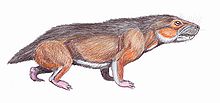| Bauriidae | |
|---|---|

| |
| Life restoration of Microgomphodon | |
| Scientific classification | |
| Domain: | Eukaryota |
| Kingdom: | Animalia |
| Phylum: | Chordata |
| Clade: | Synapsida |
| Clade: | Therapsida |
| Clade: | †Therocephalia |
| Superfamily: | †Baurioidea |
| Family: | †Bauriidae Broom, 1911 |
| Genera | |
|
†Antecosuchus | |
Bauriidae is an extinct family of therocephalian therapsids. Bauriids were the latest-surviving group of therocephalians after the Permian–Triassic extinction event, going extinct in the Middle Triassic. They are among the most advanced eutherocephalians and possess several mammal-like features such as a secondary palate and wide postcanine teeth at the back of the jaws[1] (analogous to mammalian molars). Unlike other therocephalians, bauriids were herbivorous. They were also smaller than earlier members of the group. Two subfamilies are classified within Bauriidae: Nothogomphodontinae and Bauriinae.[2]
- ^ Abdala, F.; Jashashvili, T.; Rubidge, B. S.; Den Heever, J. (2014). "New Material of Microgomphodon oligocynus (Eutherapsida, Therocephalia) and the Taxonomy of Southern African Bauriidae". Early Evolutionary History of the Synapsida. Vertebrate Paleobiology and Paleoanthropology. p. 209. doi:10.1007/978-94-007-6841-3_13. ISBN 978-94-007-6840-6.
- ^ Battail, B.; Surkov, M.V. (2003). "Mammal-like reptiles from Russia". In Benton, M.J.; Shishkin, M.A.; Unwin, D.M. (eds.). The Age of Dinosaurs in Russia and Mongolia. Cambridge: Cambridge University Press. pp. 86–119. ISBN 978-0-521-54582-2.